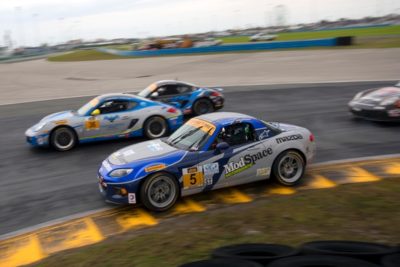Having an eye in the sky can keep a driver focused on the matter at hand and not worrying about things that aren’t important at that moment.
For most club racers, having someone talking them through a race on the radio is a foreign experience. Actually, for most club racers, having a radio in the car is a foreign experience. But those who have had the benefit of a spotter know how much it can be worth.
“I think most people will realize the first time they have a spotter in their ear how much of a load he takes off your back,” says Andrew Carbonell, who finished second in the 2015 Continental Tire SportsCar Challenge Street Tuner class driving a Freedom Autosport MX-5. “It kind of shifts your focus from having to worry about every single aspect of the race, to really just focusing on what’ s ahead of you and what you’re trying to accomplish. He kind of keeps you updated as to the gaps and the leaders.
“Where I find the most help, especially in multi-class racing, is with the traffic. As much as in a race car you have to have eyes all around your head, it makes it much easier to have a spotter tell you you’ve got a faster car approaching five cars back, or you’ve got a pack of two cars approaching and you’ll be clear after the blue one. It kind of allows you to keep your focus on what you’re doing rather than possibly be distracted by this traffic that’s coming through,” Carbonell adds.
Of course, what information you get from the spotter can be up to you. It’s the driver’s responsibility to tell the spotter what kind of information he or she wants, although in the case of multi-driver endurance racing, it’s best if all the parties come to an agreement.
“Certain drivers like certain information, whether that’s coming from the pitbox or the eyes in the sky, so to speak,” says Mazda SKYACTIV Prototype driver Tom Long, who got started with his brother, Chris, spotting for him. “Generally, drivers will agree if it’s an endurance race on what kind of information they’d like. Depending on what class you’re in…if you’re in a slower class, you’re usually getting talked about what cars are coming up. But in a fast class, information like gaps to cars ahead.
“I think it’s also a big safety piece. Certainly there are corner workers and flags and we get the TV feed beamed back to pit lane, they can all give us information. But if there’s something that instantly happens on track that’s in front of you, two turns ahead, the spotter is going to be able to relay that information to you that much quicker,” Long says.
One thing to remember is that the spotter doesn’t need anything from you, unless you have a problem or a question. He or she is there to feed the driver information, not the other way around.
“I don’t need a reply,” says Chris Long, who spots for Freedom Autosport and also helped out several drivers at the SCCA National Championship Runoffs this year. “I’m going to be feeding you a lot of information. I’m not looking for an ‘OK” or ‘Copy’ unless I’m asking you a specific question. Really, the best compliment I’ve received is that the information I provide is so intuitive that it doesn’t need thought process.”
Most club racers, though, won’t have access to a professional spotter like Chris Long. The average amateur racer will be handing his buddy or part-time mechanic the radio and telling him where to go and what to say. The driver is going to have to do a little coaching.
“I’m going to tell him, ‘Keep me as educated as possible,’” says Carbonell. “How far into the race are we? What’s the delta from me to the next car, or the car behind me? It’s really about having that extra knowledge. You have all the knowledge that you know, and you also have a whole wealth of information that you can get just by cuing a radio and ask. It allows you to keep your focus forward.”
Related Content:
How to Spot
